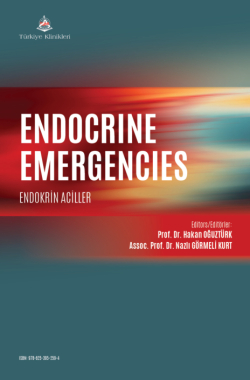Hyperthyroidism and Thyroid Storm
İbrahim DİLEKCANa , Nureddin SERVİa , Çağdaş YILDIRIMb
aAnkara Bilkent City Hospital, Clinic of Emergency Medicine, Ankara, Türkiye
bAnkara Yıldırım Beyazıt University Faculty of Medicine, Ankara Bilkent City Hospital, Department of Emergency Medicine, Ankara, Türkiye
Dilekcan İ, Servi N, Yıldırım Ç. Hyperthyroidism and thyroid storm. In: Oğuztürk H, Görmeli Kurt N, eds. Endocrine Emergencies. 1st ed. Ankara: Türkiye Klinikleri; 2024. p.45- 51.
ABSTRACT
Hyperthyroidism is an endocrinological aberration characterized by the excessive production of thyroid hormones, spans a clinical spectrum from latent subclinical presentations to formidable thyroid storm. Mortality differs according to the etiology of hyperthyroidism, early recognition, and proper treatment. There are many causes including Graves’ disease, toxic adenomas, thyroiditis. Clinical manifestations range from anxiety and palpations to severe conditions such as thyrotoxic periodic paralysis and thyroid storm which affect various organ systems. Management approaches vary based on clinical presentation and severity, encompassing supportive care, inhibition of hormone production and release, and correction of peripheral conversion. This article aimed to discuss hyperthyroidism and thyroid storm and clinical management at the emergency department of hyperthyroidism patients.
Keywords: Hyperthyroidism;thyrotoxicosis; thyroid gland; endocrine emergencies; thyroid storm
Kaynak Göster
Referanslar
- Inman BL, Long B. Thyrotoxicosis. Emerg Med Clin North Am. 2023;41(4):759-74. [Crossref] [PubMed]
- Ross DS, Burch HB, Cooper DS, Greenlee MC, Laurberg P, Maia AL, et al. 2016 American Thyroid Association Guidelines for Diagnosis and Management of Hyperthyroidism and Other Causes of Thyrotoxicosis. Thyroid. 2016;26(10):1343-421. Erratum in: Thyroid. 2017;27(11):1462. [Crossref] [PubMed]
- Pearce EN. Diagnosis and management of thyrotoxicosis. BMJ. 2006;332(7554):1369-73. [Crossref] [PubMed] [PMC]
- Williamson S, Greene SA. Incidence of thyrotoxicosis in childhood: a national population based study in the UK and Ireland. Clin Endocrinol (Oxf). 2010;72(3):358-63. [Crossref] [PubMed]
- Brent GA. Clinical practice. Graves' disease. N Engl J Med. 2008;358(24):2594-605. [Crossref] [PubMed]
- Idrose AM. Acute and emergency care for thyrotoxicosis and thyroid storm. Acute Med Surg. 2015;2(3):147-57. [Crossref] [PubMed] [PMC]
- Akamizu T, Satoh T, Isozaki O, Suzuki A, Wakino S, Iburi T, et al; Japan Thyroid Association. Diagnostic criteria, clinical features, and incidence of thyroid storm based on nationwide surveys. Thyroid. 2012;22(7):661-79. Erratum in: Thyroid. 2012;22(9):979. [Crossref] [PubMed] [PMC]
- Kornelius E, Chang KL, Yang YS, Huang JY, Ku MS, Lee KY, et al. Epidemiology and factors associated with mortality of thyroid storm in Taiwan: a nationwide population-based study. Intern Emerg Med. 2021;16(3):601-7. [Crossref] [PubMed]
- Pirahanchi Y, Tariq MA, Jialal I. Physiology, thyroid. Treasure Island (FL): StatPearls; 2022.
- Krieger CC, Neumann S, Gershengorn MC. TSH/IGF1 receptor crosstalk: Mechanism and clinical implications. Pharmacol Ther. 2020;209:107502. [Crossref] [PubMed] [PMC]
- Peeters RP, Visser TJ. Metabolism of thyroid hormone. Dartmouth: South; 2000. [Link]
- Duprez L, Hermans J, Van Sande J, Dumont JE, Vassart G, Parma J. Two autonomous nodules of a patient with multinodular goiter harbor different activating mutations of the thyrotropin receptor gene. J Clin Endocrinol Metab. 1997;82(1):306-8. [Crossref] [PubMed]
- Holzapfel HP, Führer D, Wonerow P, Weinland G, Scherbaum WA, Paschke R. Identification of constitutively activating somatic thyrotropin receptor mutations in a subset of toxic multinodular goiters. J Clin Endocrinol Metab. 1997;82(12):4229-33. [Crossref] [PubMed]
- Nordyke RA, Gilbert FI Jr, Harada AS. Graves' disease. Influence of age on clinical findings. Arch Intern Med. 1988;148(3):626-31. [Crossref] [PubMed]
- Trzepacz PT, Klein I, Roberts M, Greenhouse J, Levey GS. Graves' disease: an analysis of thyroid hormone levels and hyperthyroid signs and symptoms. Am J Med. 1989;87(5):558-61. [Crossref] [PubMed]
- Ngo SY, Chew HC. When the storm passes unnoticed--a case series of thyroid storm. Resuscitation. 2007;73(3):485-90. [Crossref] [PubMed]
- Andersen OO, Friis T, Ottesen B. Glucose tolerance and insulin secretion in hyperthyroidism. Acta Endocrinol (Copenh). 1977;84(3):576-87. [Crossref] [PubMed]
- Williams GR, Bassett JHD. Thyroid diseases and bone health. J Endocrinol Invest. 2018;41(1):99-109. [Crossref] [PubMed] [PMC]
- Swee du S, Chng CL, Lim A. Clinical characteristics and outcome of thyroid storm: a case series and review of neuropsychiatric derangements in thyrotoxicosis. Endocr Pract. 2015;21(2):182-9. [Crossref] [PubMed]
- Burch HB, Wartofsky L. Life-threatening thyrotoxicosis. Thyroid storm. Endocrinol Metab Clin North Am. 1993;22(2):263-77. [Crossref] [PubMed]
- Satoh T, Isozaki O, Suzuki A, Wakino S, Iburi T, Tsuboi K, et al. 2016 Guidelines for the management of thyroid storm from The Japan Thyroid Association and Japan Endocrine Society (First edition). Endocr J. 2016;63(12):1025-64. [Crossref] [PubMed]
- Nayak B, Burman K. Thyrotoxicosis and thyroid storm. Endocrinol Metab Clin North Am. 2006;35(4):663-86, vii. [Crossref] [PubMed]
- Modarresi M, Amro A, Amro M, Sobeih A, Okoro U, Mansoor K, et al. Management of Cardiogenic Shock due to Thyrotoxicosis: A Systematic Literature Review. Curr Cardiol Rev. 2020;16(4):326-32. [Crossref] [PubMed] [PMC]

